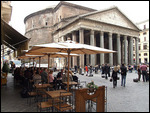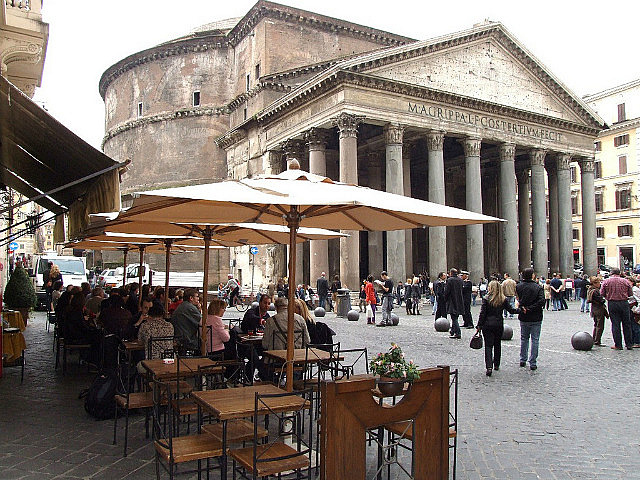The Eternal City's history can be divided into two periods: Roman Empire (to 476 AD) and Catholic Rome. Among all destinations of this trip, Rome was the only place never ruled by Muslims. Most of Rome's monuments date from the latter period, especially during and after the Renaissance. The world headquarters of Roman Catholic Church is in Vatican City, an independent country located inside the city of Rome.
753 BC - Rome founded as a city-state.
to 476 AD - capital of Roman Empire, the largest empire in the history of western world.
to 751 AD - Christian Byzantine/Greek rule from Constantinople (Istanbul, Turkey).
to 1870 - ruled by the Catholic Christian Church headquartered in Rome.
1870 - became capital of independent Italy.
Eleven of us decided to take the train from the cruise ship port Civitavecchia to Rome, instead of the pricey tour buses offered by the cruise. Since I have been to Rome before and know my way around, I became the tour leader. At the Civitavecchia train station we purchased 9 euro tickets for each person which was good for one-day train rides to and from Rome, as well as public transportation within the city. This was a really good deal. Civitavecchia is a bit run-down but the train service was comfortable and uncrowded.
This was Easter sunday when the Pope would be delivering a mass attended by 2 million people in Vatican City. We decided to avoid the crowds by visiting other sights first. Many people in the train got off at San Pietro train station, the closest to the Vatican. Once arrived at the main train station in Rome, we changed to subway to go to the Spanish Steps.
Suddenly surrounded by elegant baroque architecture, marble sculptures of the finest artisanship, and the realization that we're in the venerated "Eternal City", everyone started snapping lots of pictures. Milling around the elegant steps, the tourist horse carriages and the designer boutiques, we followed the narrow streets and alleys of old Rome. The Renaissance beauty Trevi Fountain seemed perpetually mobbed by a big crowd. Uncle Chenghua showed off his violin skills along the way, borrowing a violin from a street artist. Gazing at the 2000 year-old Pantheon temple, the oldest and best preserved monument from antiquity, one feels the imprint of many centuries gone past. We couldn't enter the Pantheon because a mass was taking place inside, but from between the centuries-old huge bronze doors we could admire its ancient interior. As we walked all around old Rome we passed by many Roman-era ruins that had been incorporated into latter day buildings, such as these massive columns.
Public restrooms were hard to find along the way, fortunately near Trevi Fountain we were able to get permission to use the bathrooms in an office building. After stopping by a unique Gothic church (Santa Maria sopra Minerva) featuring marvelous stained glass windows, we arrived at Capitoline hill, the heart of Rome. Here one can see monumental buildings from Roman, baroque, and modern eras juxtaposed on top of each other, each one making use of older structures as its foundation. Legs worn out by too much walking, Hyacinth and Chenghua waited below the many steps to the top of the hill, while the rest of us climbed up to the glorious Campidoglio piazza, designed by the great Michelangelo. This is a text book example of brilliantly-designed public space. At the top of the hill there are the elegant capitoline museums, the Roman city hall, and glorious views of the Roman Forum ruins where massive triumphant arches, huge columns still standing, and latter day churches vied for space in the sun. Unfortunately the Colosseum is hardly visible from this vantage point, obscured by a nearby church dome.
Coming back down the capitoline hill, we had a restful lunch at a nearby cafe facing bustling Piazza Venezia, where the gargantuan Vittorio Emanuele II monument dominates the scene. Another example of latter day rulers wanting to outdo their predecessors by building ever-larger monuments in the Eternal City. From here we took the bus 64 to Vatican city, a bus well-known for pickpockets. The bus ride was crowded and not so comfortable, but nobody lost any valuables. Not having used this bus I was unsure where to get off the bus, as a result we ended up at the San Pietro train station instead of the San Pietro (St Peters) square. I was rather discouraged. We got on another No. 64 bus in the opposite direction, and Novlett helped us navigate by asking around for the right place to get off the bus. Finally we arrived at St Peters square, passing by the colorfully dressed Swiss guards. At this point most of us were exhausted, my mom and Ailing each tripped and fell once, luckily they were not hurt. The massive square surrounded by hundreds of statues of saints on top of the huge colonnaded arcs is truly the most grandiose of all Roman architecture. The square was still full of chairs left from the morning mass. Because of time constraints we didn't enter the St. Peters Cathedral, nor did we visit the Roman Colosseum.
Taking a bus back to the main train station, we took a rest in an MacDonalds inside and ordered some refreshing milk shakes. I monitored the sign board for the platform number of the train to Civitavecchia, but it stayed blank. It was about 15 minutes before the train would depart, I was stressed out for not knowing how to find out the platform number. With Neil and my mom both helping we found out the information with only 10 minutes left. Then we found out the platform for the Civitavecchia train was located nearly half a mile from the main platforms, so all of us had to rush. This was very stressful for the older folks because they had been worn out by all the walking around Rome. We finally made it to the train, then it left the station after less than 30 seconds. It was a very close call. After arriving at Civitavecchia we again had to walk to the port, fortunately the shuttle bus to the ship waited for us. We were the last group to board the last shuttle bus to the cruise ship.

